This content uses affiliate links. Please read the disclosure below for more info.
Great design is timeless. Since beautiful items make your home feel special, discover some of the best design that revolutionized kitchen and tableware throughout the 20th century, and still influence our taste today.
1900

SODA SIPHON
1900, Europe
The soda siphon was invented in the 19th century, however, the early 1900s versions shaped these dispensers as we know them. The first French models were more rounded in design, but the model consisting of an elegant bottle with the distinctive protective metal mesh, topped by a polished aerator became a sensation in every household bar. Snazz up your seltzer game by getting your own here.
1910

POSTER ART
Various
1910-1919
With the revolution of the lithographic process during the late 19th century, poster art gained an important role in public life. Not only was the poster a vehicle for advertisement, but also a means of simple communication between the state and its people. The breakout of World War I and the war effort depended heavily on poster propaganda for public notification of critical issues, such as avoiding food waste. The 1910s brought on the early stages modernism, with the use of more abstract, geometric figures and flat colors.
1920
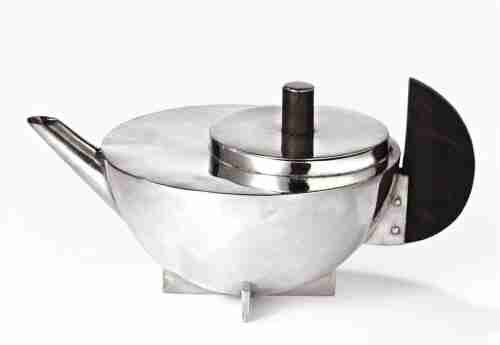
MT49 TEAPOT
Marianne Brandt, Bauhaus Dessau
c. 1927, Germany
Bauhaus. The German art school was short-lived, but left a profound impact in design, art, and architecture. Marianne Brandt, one of the school’s students (and then teacher), created one of the movement’s biggest contributes to 20th century object design. The singular combination of geometric shapes, as well as the polished silver and ebony finish, created an elegant and seamless piece. This teapot remains undeniably modern, and still a magnificent object of desire.
1930

ZEROLL ICE-CREAM SCOOP
Sherman Kelly, Zeroll
1935, USA
The utter brilliance of this small ice-cream scoop defies expectations. Sherman Kelly remembered to pursue this design while observing ice-cream parlor employees during a holiday in Florida. In his mind echoed that striking thought: there must be a better way! And indeed, there was. He designed a piece that is still as important today as it was in 1935. The scoop’s ergonomic design made it easier to work with, but more importantly, inside its aluminum frame it contained a heat-conductive liquid that allowed the heat from the hand to be conducted to the scoop, and thus melt the ice-cream while scooping it. It could have been ugly, or bland. But Kelly made it beautiful, simple, and elegant. An object built to last, both in design and utility. If you’re an ice-cream aficionado, you can pick it up here.
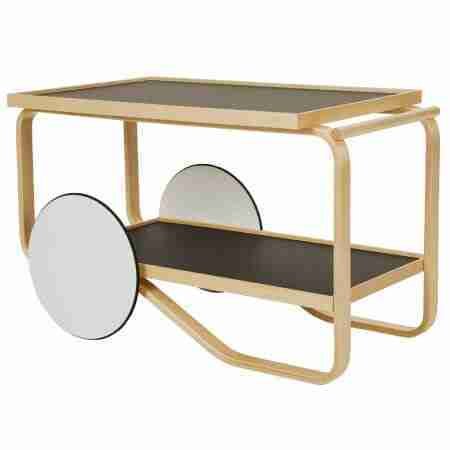
TEA TROLLEY (MODEL 98)
Alvar Aalto, Oy Huonekalu-ja Rakennustyötehdas AB
1936-1937, Finland
This graceful tea trolley was conceived in the 1930s by Finnish architect Alvar Aalto. Its jaw-dropping contemporaneity validates the design’s brilliance. The clean lines in birchwood, the linoleum topping, and unadorned wheels make this piece featherweight and easily integrated into any setting and function.
1940

STREAMLINE AUTOMATIC POP UP TOASTER
Donald Earl Dailey, Proctor-Silex
1947, USA
Streamline Moderne is inspired in late Art Deco design. This style’s use of curved forms and horizontal lines is perfectly represented in this toaster, created in 1947 by the American designer Donald Earl Dailey. The mirrored finish and curved complexion create mesmerizing shapes in its reflection. It is, perhaps, the most gorgeous toaster to ever have toasted.

CHEMEX BREWER
Peter J. Schlumbohm, Chemex
1941, USA
This ingenious coffee brewer was invented by chemist Peter Schlumbohm. His knowledge of chemistry allowed him to build a competent brewer, for which he also invented unique filters. The laboratory inspired glassware accompanied by the elegant, eccentric wooden neck and leather strap turn the Chemex into one of the 20th century most celebrated designs. It comes as no surprise that the current specialty coffee trend has made the Chemex soar in popularity once more. Don’t wait up to start brewing your own batch, snap it up here.
1950

G-TYPE SOY SAUCE DISPENSER
Marahiro Mori, Hakusan Porcelain
1958, Japan
The popularity of Japanese cuisine in the West has brought us closer with fabulous pieces of design. Perhaps the most iconic object is the G-type soy sauce dispenser, designed by Masahiro Mori in 1958 for Hakusan. The porcelain company’s gamble on this young designer proved a safe bet, as it became the company’s best selling item. It is a perfect example of form and function, as its graceful shape was planned to prevent accidental toppling over and dripping of sauce. Honor your Japanese meals by getting your piece here.
1960
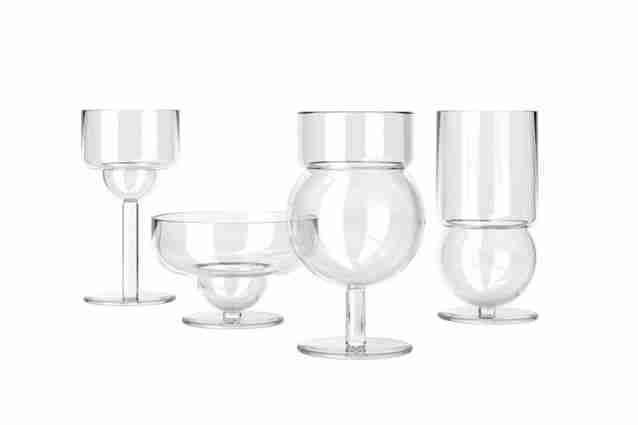
SFERICO GLASS COLLECTION
Joe Colombo, Karakter
1963, Italy
The 1960s brought democracy to great design. Such a case is the exquisite Sferico Glass Collection, a series of ten glasses designed by Joe Colombo to fit all purposes. From whiskey to water, cocktails to wine, juice to beer. Their elegant, yet unconventional design was based on simple geometric shapes and has passed the test of time. Their timeless beauty makes them as much as an object of desire now as they were back in the 1960s.
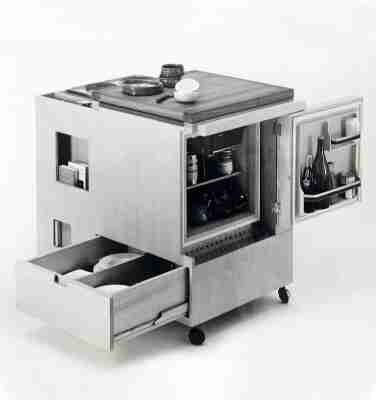
MINIKITCHEN
Joe Colombo, Boffi
1968, Italy
Joe Columbo was convinced that modern life would imply every growing space restrictions, so he decided to incorporate this need into his designs. The minikitchen Columbo designed for Boffi contains almost everything you need. A pull-out worktop, refrigerator, pantry, burners, drawers and electrical sockets. The concept of a miniature kitchen in a single module, that could be transported into any division or position, proved to be groundbreaking at the time. Nonetheless, 50 years later, the minikitchen makes more sense than ever, making it a compelling example of the 20th century’s best design.
1970

PUSHBOY BIN
Egbert Neuhaus, Wesco
1970s, USA/Germany
Around 30 years after the birth of the Danish Vipp pedal bin, Egbert Neuhaus, a young German exchange student in America was gaining inspiration. He observed the industrial American trash bins and took the idea back to Germany, where he developed a pill-shaped domestic bin with a swinging lid. The Pushboy, as it became known, became an enormous success and is still a bestseller. Grab your Pushboy here.
1980
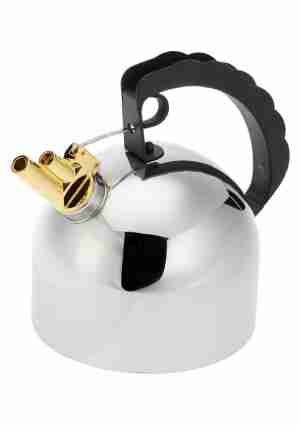
9091 KETTLE
Richard Sapper, Alessi
1983, Germany
The nervous hiss of the kettle when the water boils fills the imaginary of all generations. Richard Sapper’s brilliant idea came from his childhood memories of hearing the boat sirens over the Rhine. He created a brass whistle that is fastened to the kettle’s tip, which blows in harmonic tune when the steam crosses through it. This ingenious idea, allied to an elegant steel design, make it a 1980s statement piece. You can buy your melodic kettle here.
1990

JUICY SALIF
Philippe Starck, Alessi
1990, Italy
The 1990s took us back to minimalism, with outstanding design. Perhaps one of the most iconic pieces of that era is a citrus juicer. Juicy Salif was designed for Alessi by Philippe Starck, and quickly became a bestseller—and a classic. This sleek, polished, alienesque citrus juicer had an interesting conception. Inspiration struck while he was eating squid on a restaurant on the Amalfi coast. Starck sketched several versions of a squid-like object on a greasy napkin, which he later sent to Alessi. And that small story explains the creaturelike shape. The napkin now sits inside Alessi’s museum. You can buy it here.

SMEG ANNI 50 FRIDGE
Smeg
1997, Italy
Truth be told, this fridge needs no introduction. This unmistakable appliance was Smeg’s home run in 1997. Inspired by the chunky, rounded forms of the 1950s fridges, it brings a hint of nostalgia and celebrates the refrigerator as an object of desire, more than a machine. The design is complemented by an interesting array of striking pastel colors, as well as streamlined handles. This design has been adapted to other household appliances such as washing machines, toasters, and mixers. You can buy it here.
Disclosure: Please note that some of the links above are affiliate links, and at no additional cost to you, we will earn a commission if you decide to make a purchase after clicking through the link.

